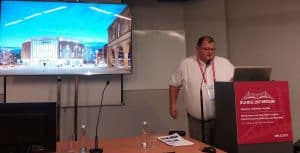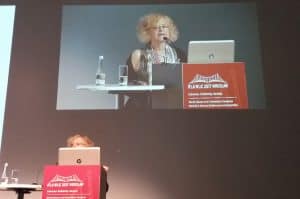
Chris Hartgerink, PhD candidate at Tilburg University in the Netherlands, wants to upend the current system of academic publishing.
“The legacy of the paper era is two opposing forces: what’s good for science and what’s good for the people who communicate science,” he told attendees at the “Being Open about Open: Academic and Research Libraries, FAIFE, Copyright, and Other Legal Matters” session of the International Federation of Library Associations and Institutions (IFLA) World Library and Information Congress on August 25.
“The paper era is done for; it’s been dead for several years,” and the problems with scholarly research are many, declared Hartgerink—paywalls and inaccessibility, nontransparency, redundancy, and impact score, to name a few. “We have these duct-taped solutions, we have all these elements inside the paper that want to break out,” he said. “If we reshape how we communicate we can make science much more efficient.”
Hartgerink was calling for no less than a revolution—not just open access, but a remodeling of the academic publishing process, so that each part of the paper is “seen as a bigger network,” everything is made accessible to everyone in the world via P2P, and the stages of research initiate the research of others.

Vanessa Proudman, program officer for SPARC Europe, presented her own 10 prerequisites to make open access the default. Some of those ideas included more partnerships between policymakers, funders, and research managers; getting institutions to take a greater role in disseminating their researchers’ work; and making sure that members of the research community are well-informed of the open access and open science tools and training that can support them.
“Publish or perish has not lost much momentum,” said Reggie Raju, deputy director of user services at the University of Cape Town in South Africa, who stressed the practical applications of accessible resources. Expensive textbooks are a barrier to education in South Africa, a nation where 54% of people live below the poverty line and 60% of college students drop out of school, mostly because of cost.
“Open access textbooks address the challenging issue of decolonization,” said Raju.
Other presentations included “Towards Open Science: China’s Scientific Research and Libraries” from Yan Zhao, associate director at China’s National Science Library in Beijing, and “The Mining Revolution: Are Libraries Supporting Researchers or Publishers?” from Peter Murray-Rust, director of the ContentMine project.
Spaces designed for everyone
The “Public Libraries as Place Makers in Today’s Cities: Urban Development, Resiliency, and Social Equity in Metropolitan Libraries” session discussed a different kind of openness and accessibility—making sure the library’s physical space is one that welcomes all.
For Steve Dickson, senior director at FaulknerBrowns Architects, the firm that designed The Word: National Centre for the Written Word in South Shields, UK, that accessibility started when it was decided to plan the town’s new layout around a centrally located library.

“People thought we were mad leading with a library as the main building,” said Dickson. “It was a great and visionary approach.” He also ignored another design rule he once read in a book: “You should never design a library as a circle.”
The idea behind the National Centre for the Written Word was to create a “democratic space” that promoted community connectivity and content creation, and a round building “facilitates a chance encounter,” he said. The library contains spaces for sharing, gathering, meetings, and contemplation, as well as a fab lab, play area, IT studio, local history section, Skype room, TV and sound studio, and terraces.
“It’s the sense of belonging that makes you come back, and we call that humancentric design,” said Dickson. “When you get a 13,000% increase in teenage membership, you’re doing something right.”
The Free Library of Philadelphia is another example of a library transforming its space to make facilities and services more accessible and equitable—in this case, for the younger set. Data Strategy and Evaluation Administrator Joel Nichols and Chief of Youth Services Christine Caputo presented “Making Space with Play: Designing and Evaluating Early Childhood Library Playspaces,” an initiative their library is piloting at three branches.
“In Philadelphia, we don’t have a lot of free spaces where kids can play,” said Caputo. “Play is the work of children. This is how they engage with the world, this is how they learn.”
The idea was to design areas for guided and open-ended play that would encourage parent–child interactions. The three branch libraries vary in demographics—Wyoming, which caters to a population that speaks 15–20 languages; Cecil B. Moore, in a predominately African American neighborhood struggling with poverty; and Whitman, which serves mixed, middle-income families.
At each library, both children and parents were asked what they envisioned for the play areas. Kids were asked to construct their ideas by building them with cardboard and fill out Mad Libs–style story prompts to describe their ideal space. Adults were asked to respond to a survey. Much of what kids and parents wanted aligned: a bright, big, and active area with sections for art, reading, storytelling, and pretending.
Schematics emerged for the individual libraries. For example, a corner stage is planned for the Whitman branch and a climbing wall planned for the Cecil B. Moore branch. “We’re hoping to encourage the kinds of play that leads to literacy development,” said Nichols.
Other presenters included Sujin B. E. Huggins, associate professor of information studies at Dominican University, with “Targeting Autism in Libraries: Serving the Needs of Persons with Autism by Considering Space, Service, Programs, and Advocacy”; Paulina Milewska, marketing specialist at the Information and Library Center of the Medical University of Łódź in Poland, with “Get Citizens on Board”; Mikkel Christoffersen and Finn Petersen from Copenhagen Libraries, with “In Copengagen, Libraries are Everywhere”; and Saara Ihamaki, director of regional library services at Helsinki City Library in Finland, with “Power to the People: Keys to Develop Attractive, Functional Services of the New Era.”
Ihamaki’s library, which also sought user input to make the facility more open and attractive to the public, shared some feedback she received from a 14-year-old in the community: “I love the girls’ room. We designed it.”


